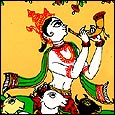|
温达文(Vrindavana)和玛图拉(Mathura)位于德里以南135公里,是奎师那奉献者最重要的朝拜圣地。奎师那出生在玛图拉,并在温达文度过了祂的童年时代。温达文有5000多座庙宇。
温达文名胜
雅沐娜河(Yamuna River)
雅沐娜河流经温达文和玛图拉,是印度最神圣的河流之一,因为她与奎师那的逍遥时光有着密不可分的关系。在雅沐娜河畔座落着Keshi Ghat(通向河里的台阶),是奎师那杀死恶魔克什(KESHI),拯救祂的朋友的地方。在此沐浴能够得到在所有圣地沐浴的益处。
奎师那·巴拉茹阿庙(Krishna Balarama Mandir)
奎师那·巴拉茹阿玛庙是益世康最主要的中心之一。这座由美丽的大理石组成的庙建于1975年,里面供奉着勾惹-尼太、奎师那-巴拉茹阿玛、茹阿达-夏玛逊达尔(Gaura-Nitai, Krishna Balarama, Radha-Syamasundara)。在庙前,是圣帕布帕德的纪念堂(Samadhi Mandir)。1977年他隐迹后,遗体就埋葬在此。他居住过的房子被改为博物馆。庙旁还有一处宾馆、餐厅、学校(gurukula)、牛棚(goshalla)。
茹阿达·勾文达吉庙(Sri Sri Radha Govindaji Mandir
1590年,由曼·辛格玛哈茹阿佳为施利拉·茹帕·勾斯瓦米发现的原始勾文达吉神像所建。1670年,当穆斯林国王奥让则布(Aurangzeb)毁坏了部分庙宇时,勾文达吉被从此庙转移到了斋普尔(JAIPUR)重新安放。这里也安放着其他一些神像。由于此庙有部分被毁坏,崇拜活动移到新的勾文达吉庙进行(在旧庙后面)。
施利·施利·茹阿达·玛丹·莫汗庙(Sri Sri Radha Madan Mohan Mandir)
Sanatana Goswami discovered the Deity of Madan Mohan. Ram das Kapoor,
a merchant donated the funds for this mandir in 1580. When the Muslims
attacked in 1670, the original Deities were moved to Karoli. Worship
is done in the new Madan Mohan Mandir to the replacement Madan Mohan
Deity.
The bhajan kutir and samadhi of Sanatana Goswami,
together with the puspa-samadhis of Candrasekhara Acharya
and Tapana Misra are also here.
Sri Sri Radha Raman Mandir
The Deity of Sri Radha-Raman (one of the few original Deities still
left in Vrindavana) was installed here by Srila Gopal Bhatta Dasa
Goswami. The Deity manifested from one of the Goswami's shaligram-shilas
in 1542. Gopal Bhatta also brought Caitanya Mahaprabhu's kaupina
(cloth) and asana (seat ) back from Puri. These can be
seen three to four times a year. Gopal Batta's Samadhi is located
here. The fires for cooking in the temple kitchen have been burning
continuously since the Deity was installed over 435 years ago.
Sri Sri Radha Gokulananda
Mandir
Here are the the Radha-Vinod Deities of Lokanath Goswami, Radha-Gokulananda
Deities of Viswanath Cakravarti, Caitanya Mahaprabhu Deity of Narottama
Dasa Thakur, Vijaya Govinda Deities of Baladeva Vidyabhusana, and
the Govardhan-shila given to Raghunath Dasa Goswami by Sri Caitanya.
Also, the samadhis of Srila Lokanath Goswami, Srila Narrottama
Dasa Thakura, and Viswanath Cakravarti Thakura lie here.
Seva Kunja and Nidhu ban
Seva Kunja and Nidhuban are gardens where Krishna performed many
of His pastimes.
Seva Kunja surrounds the temple of Srimati Radharani . Here Krishna
would massage Radharani's feet and decorate her hair with flowers.
Today this place is surrounded by temples. The Seva Kunja road leads
to Srila Jiva Goswami's Radha Damodar Temple, Srila Syamananda Goswami's
Radha Syamasundara temple, and Srila Krishna Dasa Kaviraj Goswami's
Radha-Vrindavana-Chandra Temple.
Sri Gopesvara Mahadeva Mandir
This is the oldest temple in Vrindavana. Gopesvara Mahadeva is Lord
Siva, who came to Vrindavana to become a gopi of Krishna.
Here Vrinda Devi blessed Lord Siva and allowed him to enter the
rasa dance of Lord Krishna. Lord Krishna then offered Lord
Siva the guardianship of the Rasa Lila , and placed him in the entrance
of the Mandir. Ever since, all Vaisnavas pray first for his mercy
to become a servant of the servant of the gopis. Vajranabha,
the great grandson of Krishna, also installed the Siva-linga in
this temple
Sri Caitanya Mahaprabhu's
Imlitala
The sacred Imlitala tree is where Srila Sanatana Goswami established
the worship of Sri Sri Gaura Nitai. Caitanya Mahaprabhu used to
sit daily under the Imli Tala. A Deity of Caitanya Mahaprabhu is
installed under this tree.
Sri Sri Radha Damodara
This is the temple of Srila Jiva Goswami, and the Radha Damodara
Deities. (As well as the -Vrindavan Candra Deities worshipped by
Krishna Dasa Kaviraja Goswami, the Radha-Madhava Deities of Jayadeva
Goswami, and the Radha-Chalacikana Deities of Bhugarbha Goswami).
The samadhis of Srila Rupa Goswami, Srila Jiva Goswami and
Srila Krishna Dasa Kaviraj Goswami lie here.
Srila Prabhupada lived here for six years from 1959 to 1965. He
translated the first three cantos of the Srimad-Bhagavatam here
before starting his journey to America.
Banke Bihari Mandir
Established in 1864 by Haridas Swami, this is one of the the most
popular temples in Vrindavana, especially, during Jhulan Yatra,
the swing festival.
< Back · Top
^ |
